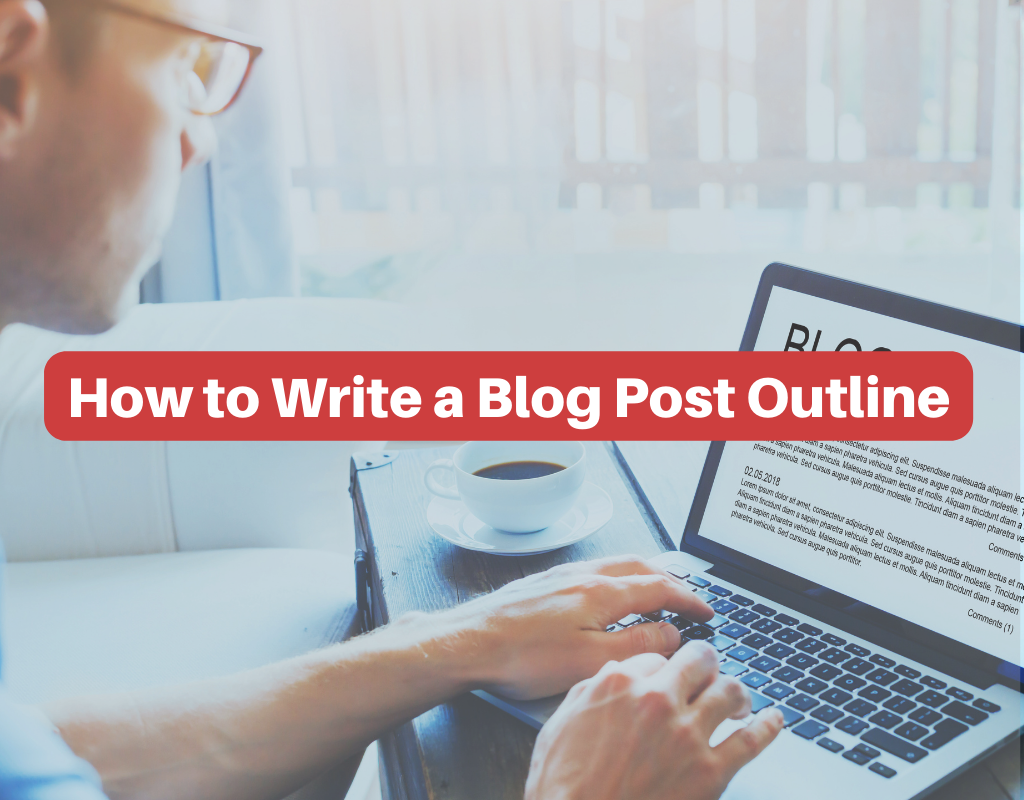For a beginner (and experts too, at times) writing a blog post is daunting.
You can spend hours staring at a blank page or writing app, not sure how to begin.
You can feel confused and stressed out trying to create a blog post.
Fortunately, you can overcome these writing blocks with a simple tool: a blog post outline.
Writers, journalists, and academics have always used outlines as part of the writing process.
And when you learn what it is and how to apply it, you’ll write a blog post in less than a day – no sweat. Perhaps in a few hours or even less.
This post will help you start writing and overcome writer’s block.
You’ll draft easy-to-read and insightful content while reducing the time and effort you spend to write a blog post.
What is a blog post outline?
A blog post outline is a simple tool that helps you structure your thoughts and ideas into a coherent article.
It’s a blueprint or structure for your blog post. It includes:
- The key points you want to make
- How you’ll support those points
- And the order in which you’ll present them
- Along with other elements like links, images, questions, and more
Creating a comprehensive outline will help you build a logical flow for your writing. Your blog posts will make sense, answer your audience’s questions, and meet your goals too. Whether it’s to become a thought leader, create a resource for the customer journey, or make the writing process faster.
Why you need a blog post outline?
Whether you’re a freelance writer, a content creator, or a blogger, you’ll need a detailed outline for your posts.
Content outlines can help streamline your content creation process. It’s also a necessary skill that any writer should have. Here are several reasons and practical cases where knowing how to write a blog post outline comes in handy:
- It saves you time
- It improves the quality of your blog post
- It helps draft a logical sequence of information
- A blog post outline helps you identify information gaps
- Editors, publishers, and content managers often ask for an article outline before approving a pitch for a post or article
- You’ll Remember to add keywords in the right places
- You’ll avoid writer’s block and procrastination
- And you’ll reduce your stress and confusion while creating content
- You can reuse your blog post outline for similar posts
Having a detailed outline for your content removes the guesswork from writing.
You’ll know exactly what to write, how to support your claims, and in what order to present your information.
You’ll also avoid distractions and tangents that can kill your productivity.
With an outline, you can focus on creating quality content without worrying about how to structure it.
How to write a blog post outline
Creating a compelling blog post outline doesn’t have to be complicated.
At its heart, it’s about the three essential components of any content:
- The introduction
- The body
- And the conclusion.
However, there are a few more steps to build a solid blog outline for a post for modern blog writing purposes. And we’ll cover them all.
As you keep reading this post, we’ll break down the outlining process to create the perfect blog post formats.
Don’t underestimate what a complete outline can do for you. It can improve the quality of your writing, help move audiences through the sales funnel, and support a marketing strategy.
Sounds good? Awesome.
Let’s explore how to write a blog post outline.
1. Start with research
The first step to any type of content creation is doing your research.
At this stage, you will have a general topic in mind. But it isn’t enough to get started.
You need to do deep research and find out information about the following:
- Is there a need for content on this specific topic?
- Who is this blog content for?
- What are the goals or objectives of this blog post?
- Who is your competition? What have they already covered on this topic?
- What content exists already around this topic?
Start browsing information to see what’s out there. You’ll start getting ideas for what to write.
At this stage, it’s essential to do your keyword research so that your content appears for specific target keywords.
Identify and write down your focus keyword, related keyword phrases, and other details.
Doing keyword research will help you pick relevant topics to write on. And you create a higher likelihood for your post to appear in a Google search result page.
2. Create a blog post title
Now that you’ve done your initial research, you’re ready to put something down.
Let’s start with the blog post title.
Your title is the first thing people will see when they find your blog post. It also describes the main idea of your post.
So, it plays a critical role in outlining your blog post.
Having a working title at the top of your document will remind you of your focus and help you stay on track as you write.
As you go through the outlining process, you can refer to the post title and see if you’re providing relevant information.
Does your content answer the question posed in the working title? Are the points in your post relevant to the blog topic?
Write the blog post title first – you can always change it later, but the main theme of the topic should stay consistent to help you create a useful blog post outline.
3. Brainstorm your main ideas
You’ve got your title. Now the next step is to do a brain dump by brainstorming a list of all the main points you want to cover.
Don’t overthink it – just put down every single idea that comes to mind on a writing app or a piece of paper.
Write it in a list format.
Once you have your list, you can then start grouping those points together into logical sections. You’ll keep some of your points and discard others.
As a final step, organize your list and ensure a natural flow from one to the other.
I recommend that you stick to creating bullet points at first. Don’t create whole paragraphs yet. We’ll work on that later.
This step will give you a great deal of clarity. You’ll have a good idea of what your post will look like and how it will appear to your audience too.
4. Create the introduction
With your blog title up, you need to create an introduction that does the following:
- Introduce the reader to what the post is about
- Engage your reader by creating a powerful opening hook
- Pose a problem, pain point, or predicament that your post will resolve
- Give readers a reason for reading your post
- Transition to the next section
It may seem like you have to achieve a lot with a few lines, but with practice, you’ll craft powerful introductions that pull people to read your whole post.
Here are some important tips to remember when you build your introductory paragraph.
- Start with a question or a statement that makes people curious
- Mention something that people struggle with related to the blog topic
- Write how your post can solve this problem and improve people’s experiences
- Ask readers to engage and keep reading to find the information they need
Remember, when writing blog outlines, use bullet points and semi-formed sentences.
You don’t need to build the introduction any further for now. Just get a ‘skeleton’ for your post down and flesh it out later.
5. Organize the main ideas of the blog post body
Once you’ve made your introduction, the next logical step is to get to the body of your blog content.
This is where you solve the reader’s problem, educate them on a topic, and meet their need through your writing.
When creating blog content, you need to divide your post into sections.
And each section should focus on a single key idea – key ideas that deliver the promise made by the blog post title.
So, at this stage, look at your list of points and separate them into different sections. Each section should focus on a sub-topic and relate to the overall post.
For example, imagine that your post title is ‘How to organize a wedding anniversary party’.
Your main points could include things like – hiring a caterer, creating a theme, buying party favors, making a list of guests… and so on.
It becomes pretty clear that some ideas or points should be at the beginning of the post and some further below.
You can also group some ideas since they are similar in theme.
This way, you’ll have a meaningful body for your blog post outline. And it will be easy to read, logical, and practical.
6. Use headings and subheadings
Online readers are looking for information that they can consume fast.
And because they don’t want to waste time on an irrelevant blog post, they scan blog posts fast.
They scroll up and down your blog page, looking for keywords and phrases to jump out at them.
You need to cater to this practice by using headings and subheadings.
A heading is a larger, more significant title that breaks up your blog content. It’s like a mini-topic that sits within the greater subject of your post.
A subheading is a title for a smaller section under a heading. It furthers the reader’s understanding of the heading by providing more specific details.
Both headings and subheadings help to outline your blog post by breaking it down into smaller, more digestible chunks.
It also helps search engines understand your content’s structure and relevancy.
If you use WordPress, you can easily add headings by using the ‘Heading’ drop-down menu in the post editor.
Select the appropriate heading size for your title (H2 for headings, H3 for subheadings) and start typing.
If you don’t use WordPress, you can still create headings on Google Docs, Microsoft Word, and virtually any writing app.
7. Build your conclusion
You’ve covered the main points of your blog post. It’s time to wrap things up.
This is where you conclude your post with a summary, additional information, or a few words of encouragement.
Find a way to draw readers back to the main topic, get them to take action, or leave them thinking.
An important thing you should add is a call to action or a C2A. A call to action is a statement that tells the reader what you want them to do.
Here are a few examples of calls to action you could add to the end of your blog post:
- Leave a comment
- Share this post with your friends!
- Send an email through our contact form
- Follow us on social media by clicking on this link!
And so on.
Adding calls to action like this ensures that your blog posts are driving traffic and engagement on your site.
So always remember to adding a note or a sentence about including C2As in the concluding paragraph.
8. Include other elements
Your blog post outline is almost complete!
The final step is to add in any additional elements that will make your post more interesting and engaging.
These elements include:
- The word count for your post
- Questions you think your audience wants answers to
- Links to internal and external content
- Adding the target keyword or keyword phrase to the right places (like the title, first paragraph, heading)
- Notes, dos and don’ts, and reminders you might forget about
And so on. Remember, your goal is to make your blog post outline as complete as possible so that you can publish a high-quality post that will drive traffic and engagement.
So there you have it – a step by step process on how to write a blog post outline.
Go ahead and share it with your client, boss, or team. You’ll get an editor’s note on ways to improve or get the approval to move forward.
Now you’re ready to get started with creating the post for real!
And I’ve got that covered too. Keep reading for tips on transforming the same outline into a readable and engaging post your readers will love.
Blog Outline Example
Here are a few blog outline examples to help you understand what they look like.
Blog outline example 1:
H1- Title -’ How To Write Engaging Copies’ – Outline
Introduction
- In the marketing and advertising world, the ability to write engaging copies is a valuable skill.
- You need to write content that captures your audience’s attention and inspires them to take action
- But how do you write copy that stands out in a sea of online content?
- Here are some of the ways.
H2 – Main Body – Tips For Writing Engaging Copies
- H3 – Know Your Audience: Before you start writing, you need to know who you’re writing for.
- H3- Get Noticed with Your Headline: make them catchy and attention-grabbing
- H3 – Keep it Simple: Use simple language, and short sentences, and avoid jargon or technical terms
- H3 – Weave a Story: People love stories, make use of your storytelling techniques
- H3 – Use a Call to Action: Use a clear and compelling call to action (CTA) to encourage your reader
- H3 – Edit: Edit out the things you feel are irrelevant.
H2 – Conclusion
- Writing engaging copies is an art that takes practice and patience
- Just keep it simple and go on creating content
- Be sure to create content and keep your customers in mind before doing anything
Keep creating copy that captivates your audience and drives results
What to do after you’ve created your blog outline
A thoroughly hashed-out blog outline is half the work done when it comes to content creation.
But it’s still helpful to go through the entire process of turning your outline into comprehensive article of post. Here’s what you should do next.
Flesh out your blog post outline into a complete draft
By now, you’ve mapped out your thoughts to ensure that your topic idea is informative and interesting.
So, get started and expand your outline. You can do this by transforming your bullet points into complete sentences. And then putting the sentences together to form paragraphs.
You must create a cohesive reading experience by linking each bullet point in your list with phrases to bridge them together.
Add examples, additional points, and relevant information that supports your main ideas. It isn’t necessary that you strictly follow the outline you’ve built. It’s a solid framework and now it’s up to you to make it into a great first draft.
What’s great about creating a structured outline is that you can turn it into a blog outline template. And you can repeatedly reuse it to make the blog writing process much more manageable.
Edit your blog post
Once you’ve written out your complete draft, it’s time to edit. This is where you check for grammar mistakes, typos, and clarity issues.
You might also want to consider hiring a professional editor if you’re not confident in your editing skills.
Or simply reach out to a friend, teammate, or family member and ask them to take a look at your post before you hit publish.
It’s also a good idea to use a content writing tool like Grammarly to help you catch any errors you might have missed.
There are other free and premium writing tools you should check out to improve your draft.
Add images, videos, and other multimedia
Make your blog post pop by adding images, videos, or other forms of multimedia.
Not only does this help to break up your content and make it more visually appealing, but it can also help to support your points and keep readers engaged.
When adding multimedia to your blog post, be sure to optimize each piece for the web.
This means compressing images so that they load quickly, choosing the correct file format, and adding captions or alt text where appropriate.
Add internal and external links
Linking to other relevant articles, websites, and resources is a great way to add value to your blog post.
Not only does it provide readers with additional information, but it can also help to improve your SEO.
Just be sure not to go overboard with your links. A few high-quality links are better than a dozen low-quality ones.
Also, remember to add internal links. These are links from one blog post to another within the same website or domain.
Internal links help to keep readers engaged with your site longer. And it can also help to improve your SEO since search engines use them to crawl and index your website.
Include your focus keyword wherever appropriate
And don’t forget to add the phrases and words you discovered during the keyword research phase!
Including your focus keyword(s) throughout your blog post will help improve your SEO. But be sure to use them naturally and avoid keyword stuffing.
The best practices are:
- To include the target keyword in your blog post title
- To include it in a heading in your post
- To insert it within the first 300 words of your post
- To add variations of the keyword phrase across your content in a meaningful way
- To add related terms that are associated with the keyword
And that’s pretty much it!
We’ve just gone through the thought process of an efficient and expert blog writer.
By following these steps, you’re certain to build great posts and a successful blog too!
Start writing your blog outline today!
Now that you know how to create a blog post outline, it’s time to put your skills to the test.
Start by brainstorming some ideas for topics that you’re interested in or passionate about. Then, follow our eight-step process to create an outline that will help you produce high-quality content.
And finally, edit and polish your draft until it’s ready for publication.
By using an outline template like this, you’ll ensure that all your posts have a consistent writing style.
And your readers will love your work. I hope this post helps. Leave a comment if you have more questions. Or share this post with someone who could use it.







